Xiaodan Liang
Product1M: Towards Weakly Supervised Instance-Level Product Retrieval via Cross-modal Pretraining
Aug 09, 2021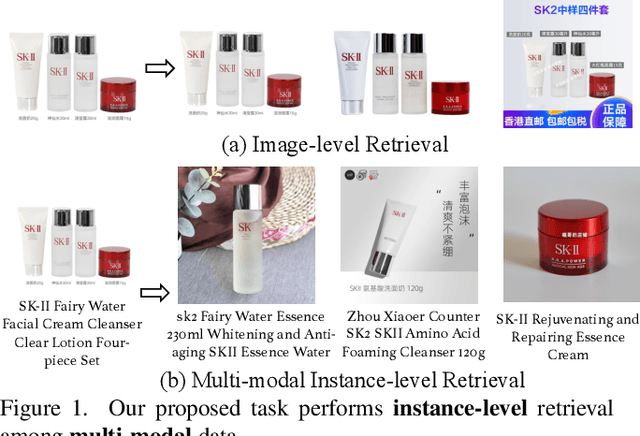

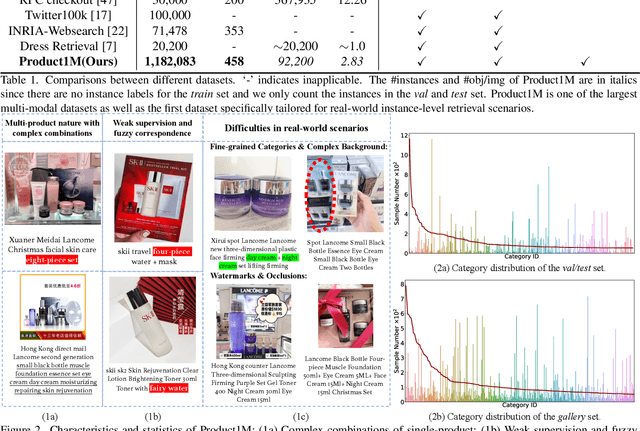

Abstract:Nowadays, customer's demands for E-commerce are more diversified, which introduces more complications to the product retrieval industry. Previous methods are either subject to single-modal input or perform supervised image-level product retrieval, thus fail to accommodate real-life scenarios where enormous weakly annotated multi-modal data are present. In this paper, we investigate a more realistic setting that aims to perform weakly-supervised multi-modal instance-level product retrieval among fine-grained product categories. To promote the study of this challenging task, we contribute Product1M, one of the largest multi-modal cosmetic datasets for real-world instance-level retrieval. Notably, Product1M contains over 1 million image-caption pairs and consists of two sample types, i.e., single-product and multi-product samples, which encompass a wide variety of cosmetics brands. In addition to the great diversity, Product1M enjoys several appealing characteristics including fine-grained categories, complex combinations, and fuzzy correspondence that well mimic the real-world scenes. Moreover, we propose a novel model named Cross-modal contrAstive Product Transformer for instance-level prodUct REtrieval (CAPTURE), that excels in capturing the potential synergy between multi-modal inputs via a hybrid-stream transformer in a self-supervised manner.CAPTURE generates discriminative instance features via masked multi-modal learning as well as cross-modal contrastive pretraining and it outperforms several SOTA cross-modal baselines. Extensive ablation studies well demonstrate the effectiveness and the generalization capacity of our model. Dataset and codes are available at https: //github.com/zhanxlin/Product1M.
NASOA: Towards Faster Task-oriented Online Fine-tuning with a Zoo of Models
Aug 07, 2021


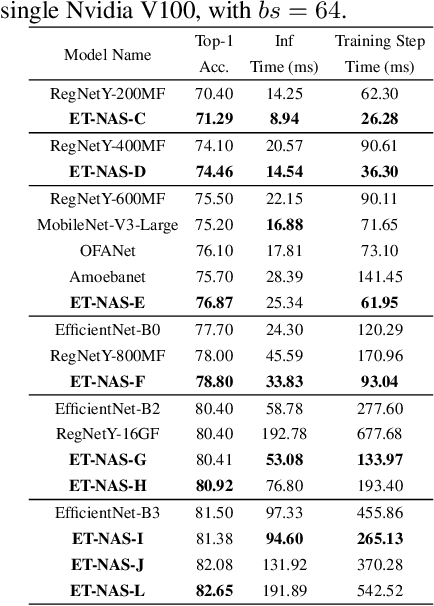
Abstract:Fine-tuning from pre-trained ImageNet models has been a simple, effective, and popular approach for various computer vision tasks. The common practice of fine-tuning is to adopt a default hyperparameter setting with a fixed pre-trained model, while both of them are not optimized for specific tasks and time constraints. Moreover, in cloud computing or GPU clusters where the tasks arrive sequentially in a stream, faster online fine-tuning is a more desired and realistic strategy for saving money, energy consumption, and CO2 emission. In this paper, we propose a joint Neural Architecture Search and Online Adaption framework named NASOA towards a faster task-oriented fine-tuning upon the request of users. Specifically, NASOA first adopts an offline NAS to identify a group of training-efficient networks to form a pretrained model zoo. We propose a novel joint block and macro-level search space to enable a flexible and efficient search. Then, by estimating fine-tuning performance via an adaptive model by accumulating experience from the past tasks, an online schedule generator is proposed to pick up the most suitable model and generate a personalized training regime with respect to each desired task in a one-shot fashion. The resulting model zoo is more training efficient than SOTA models, e.g. 6x faster than RegNetY-16GF, and 1.7x faster than EfficientNetB3. Experiments on multiple datasets also show that NASOA achieves much better fine-tuning results, i.e. improving around 2.1% accuracy than the best performance in RegNet series under various constraints and tasks; 40x faster compared to the BOHB.
WAS-VTON: Warping Architecture Search for Virtual Try-on Network
Aug 01, 2021
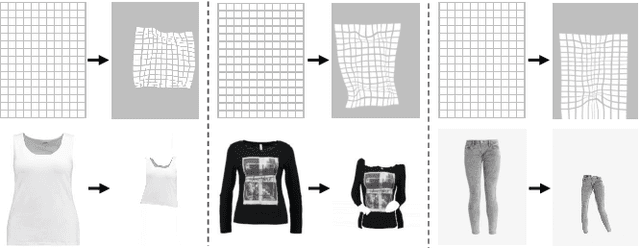

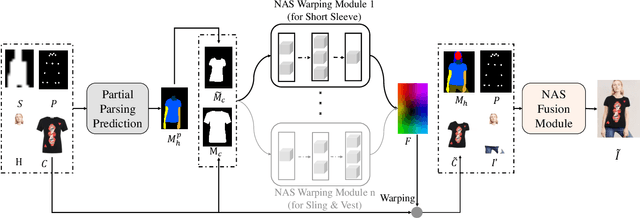
Abstract:Despite recent progress on image-based virtual try-on, current methods are constraint by shared warping networks and thus fail to synthesize natural try-on results when faced with clothing categories that require different warping operations. In this paper, we address this problem by finding clothing category-specific warping networks for the virtual try-on task via Neural Architecture Search (NAS). We introduce a NAS-Warping Module and elaborately design a bilevel hierarchical search space to identify the optimal network-level and operation-level flow estimation architecture. Given the network-level search space, containing different numbers of warping blocks, and the operation-level search space with different convolution operations, we jointly learn a combination of repeatable warping cells and convolution operations specifically for the clothing-person alignment. Moreover, a NAS-Fusion Module is proposed to synthesize more natural final try-on results, which is realized by leveraging particular skip connections to produce better-fused features that are required for seamlessly fusing the warped clothing and the unchanged person part. We adopt an efficient and stable one-shot searching strategy to search the above two modules. Extensive experiments demonstrate that our WAS-VTON significantly outperforms the previous fixed-architecture try-on methods with more natural warping results and virtual try-on results.
Adversarial Reinforced Instruction Attacker for Robust Vision-Language Navigation
Jul 23, 2021



Abstract:Language instruction plays an essential role in the natural language grounded navigation tasks. However, navigators trained with limited human-annotated instructions may have difficulties in accurately capturing key information from the complicated instruction at different timesteps, leading to poor navigation performance. In this paper, we exploit to train a more robust navigator which is capable of dynamically extracting crucial factors from the long instruction, by using an adversarial attacking paradigm. Specifically, we propose a Dynamic Reinforced Instruction Attacker (DR-Attacker), which learns to mislead the navigator to move to the wrong target by destroying the most instructive information in instructions at different timesteps. By formulating the perturbation generation as a Markov Decision Process, DR-Attacker is optimized by the reinforcement learning algorithm to generate perturbed instructions sequentially during the navigation, according to a learnable attack score. Then, the perturbed instructions, which serve as hard samples, are used for improving the robustness of the navigator with an effective adversarial training strategy and an auxiliary self-supervised reasoning task. Experimental results on both Vision-and-Language Navigation (VLN) and Navigation from Dialog History (NDH) tasks show the superiority of our proposed method over state-of-the-art methods. Moreover, the visualization analysis shows the effectiveness of the proposed DR-Attacker, which can successfully attack crucial information in the instructions at different timesteps. Code is available at https://github.com/expectorlin/DR-Attacker.
* Accepted by TPAMI 2021
Don't Take It Literally: An Edit-Invariant Sequence Loss for Text Generation
Jul 23, 2021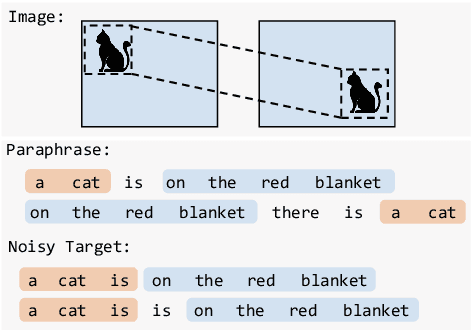
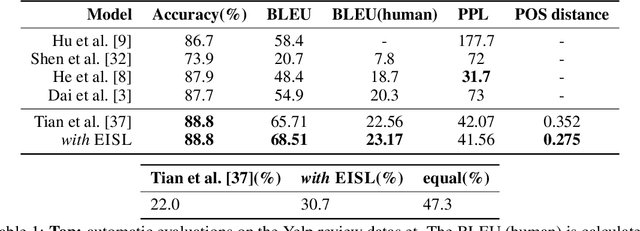


Abstract:Neural text generation models are typically trained by maximizing log-likelihood with the sequence cross entropy loss, which encourages an exact token-by-token match between a target sequence with a generated sequence. Such training objective is sub-optimal when the target sequence not perfect, e.g., when the target sequence is corrupted with noises, or when only weak sequence supervision is available. To address this challenge, we propose a novel Edit-Invariant Sequence Loss (EISL), which computes the matching loss of a target n-gram with all n-grams in the generated sequence. EISL draws inspirations from convolutional networks (ConvNets) which are shift-invariant to images, hence is robust to the shift of n-grams to tolerate edits in the target sequences. Moreover, the computation of EISL is essentially a convolution operation with target n-grams as kernels, which is easy to implement with existing libraries. To demonstrate the effectiveness of EISL, we conduct experiments on three tasks: machine translation with noisy target sequences, unsupervised text style transfer, and non-autoregressive machine translation. Experimental results show our method significantly outperforms cross entropy loss on these three tasks.
AutoBERT-Zero: Evolving BERT Backbone from Scratch
Jul 15, 2021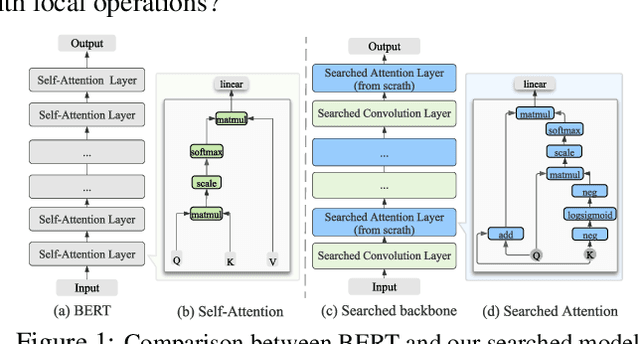
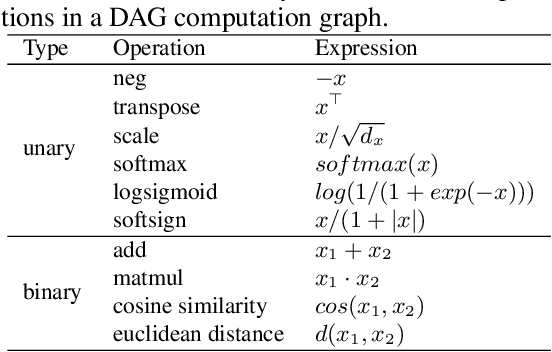

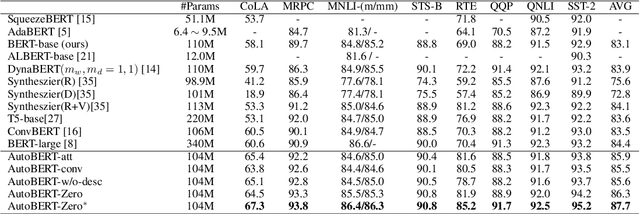
Abstract:Transformer-based pre-trained language models like BERT and its variants have recently achieved promising performance in various natural language processing (NLP) tasks. However, the conventional paradigm constructs the backbone by purely stacking the manually designed global self-attention layers, introducing inductive bias and thus leading to sub-optimal. In this work, we propose an Operation-Priority Neural Architecture Search (OP-NAS) algorithm to automatically search for promising hybrid backbone architectures. Our well-designed search space (i) contains primitive math operations in the intra-layer level to explore novel attention structures, and (ii) leverages convolution blocks to be the supplementary for attention structure in the inter-layer level to better learn local dependency. We optimize both the search algorithm and evaluation of candidate models to boost the efficiency of our proposed OP-NAS. Specifically, we propose Operation-Priority (OP) evolution strategy to facilitate model search via balancing exploration and exploitation. Furthermore, we design a Bi-branch Weight-Sharing (BIWS) training strategy for fast model evaluation. Extensive experiments show that the searched architecture (named AutoBERT-Zero) significantly outperforms BERT and its variants of different model capacities in various downstream tasks, proving the architecture's transfer and generalization abilities. Remarkably, AutoBERT-Zero-base outperforms RoBERTa-base (using much more data) and BERT-large (with much larger model size) by 2.4 and 1.4 higher score on GLUE test set. Code and pre-trained models will be made publicly available.
Deep Learning for Embodied Vision Navigation: A Survey
Jul 07, 2021
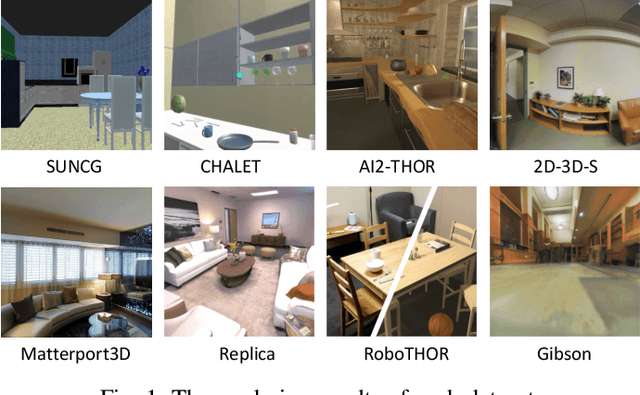

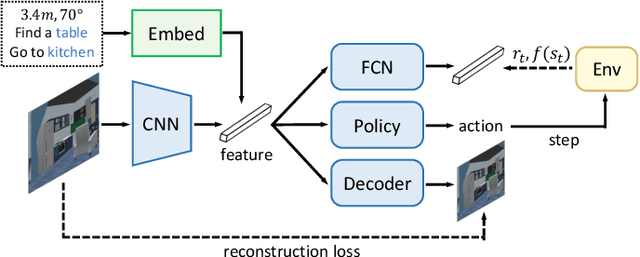
Abstract:Navigation is one of the fundamental features of a autonomous robot. And the ability of long-term navigation with semantic instruction is a `holy grail` goals of intelligent robots. The development of 3D simulation technology provide a large scale of data to simulate the real-world environment. The deep learning proves its ability to robustly learn various embodied navigation tasks. However, deep learning on embodied navigation is still in its infancy due to the unique challenges faced by the navigation exploration and learning from partial observed visual input. Recently, deep learning in embodied navigation has become even thriving, with numerous methods have been proposed to tackle different challenges in this area. To give a promising direction for future research, in this paper, we present a comprehensive review of embodied navigation tasks and the recent progress in deep learning based methods. It includes two major tasks: target-oriented navigation and the instruction-oriented navigation.
Neural-Symbolic Solver for Math Word Problems with Auxiliary Tasks
Jul 03, 2021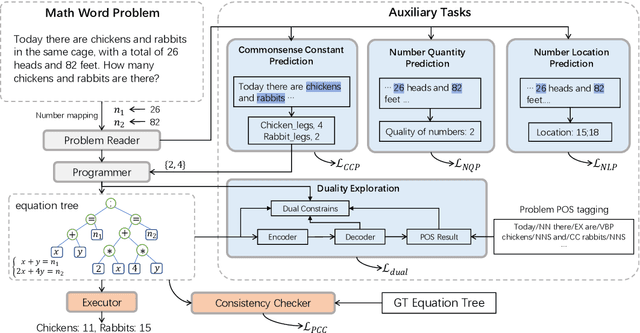
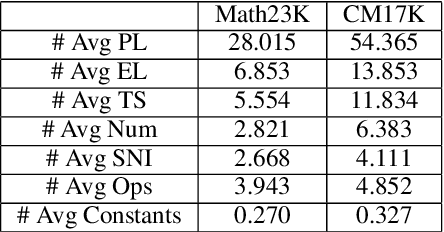
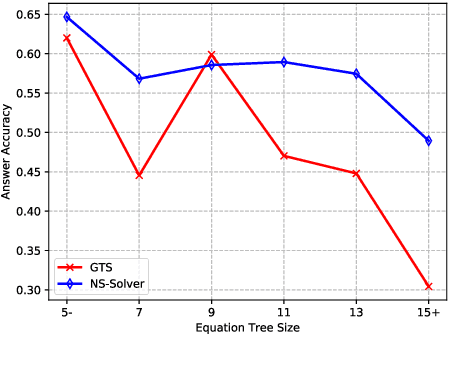
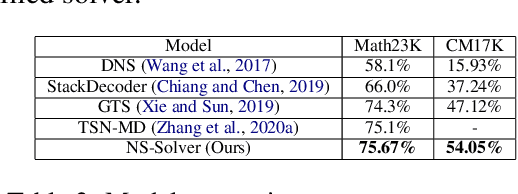
Abstract:Previous math word problem solvers following the encoder-decoder paradigm fail to explicitly incorporate essential math symbolic constraints, leading to unexplainable and unreasonable predictions. Herein, we propose Neural-Symbolic Solver (NS-Solver) to explicitly and seamlessly incorporate different levels of symbolic constraints by auxiliary tasks. Our NS-Solver consists of a problem reader to encode problems, a programmer to generate symbolic equations, and a symbolic executor to obtain answers. Along with target expression supervision, our solver is also optimized via 4 new auxiliary objectives to enforce different symbolic reasoning: a) self-supervised number prediction task predicting both number quantity and number locations; b) commonsense constant prediction task predicting what prior knowledge (e.g. how many legs a chicken has) is required; c) program consistency checker computing the semantic loss between predicted equation and target equation to ensure reasonable equation mapping; d) duality exploiting task exploiting the quasi duality between symbolic equation generation and problem's part-of-speech generation to enhance the understanding ability of a solver. Besides, to provide a more realistic and challenging benchmark for developing a universal and scalable solver, we also construct a new large-scale MWP benchmark CM17K consisting of 4 kinds of MWPs (arithmetic, one-unknown linear, one-unknown non-linear, equation set) with more than 17K samples. Extensive experiments on Math23K and our CM17k demonstrate the superiority of our NS-Solver compared to state-of-the-art methods.
SODA10M: Towards Large-Scale Object Detection Benchmark for Autonomous Driving
Jun 22, 2021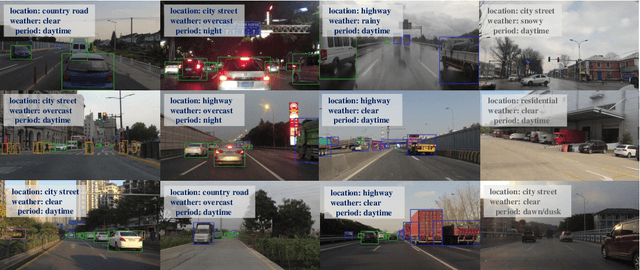

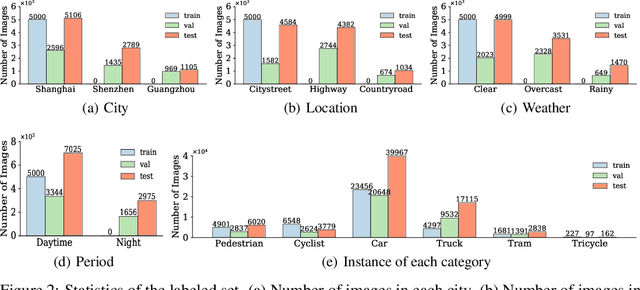

Abstract:Aiming at facilitating a real-world, ever-evolving and scalable autonomous driving system, we present a large-scale benchmark for standardizing the evaluation of different self-supervised and semi-supervised approaches by learning from raw data, which is the first and largest benchmark to date. Existing autonomous driving systems heavily rely on `perfect' visual perception models (e.g., detection) trained using extensive annotated data to ensure the safety. However, it is unrealistic to elaborately label instances of all scenarios and circumstances (e.g., night, extreme weather, cities) when deploying a robust autonomous driving system. Motivated by recent powerful advances of self-supervised and semi-supervised learning, a promising direction is to learn a robust detection model by collaboratively exploiting large-scale unlabeled data and few labeled data. Existing dataset (e.g., KITTI, Waymo) either provides only a small amount of data or covers limited domains with full annotation, hindering the exploration of large-scale pre-trained models. Here, we release a Large-Scale Object Detection benchmark for Autonomous driving, named as SODA10M, containing 10 million unlabeled images and 20K images labeled with 6 representative object categories. To improve diversity, the images are collected every ten seconds per frame within 32 different cities under different weather conditions, periods and location scenes. We provide extensive experiments and deep analyses of existing supervised state-of-the-art detection models, popular self-supervised and semi-supervised approaches, and some insights about how to develop future models. The data and more up-to-date information have been released at https://soda-2d.github.io.
One Million Scenes for Autonomous Driving: ONCE Dataset
Jun 21, 2021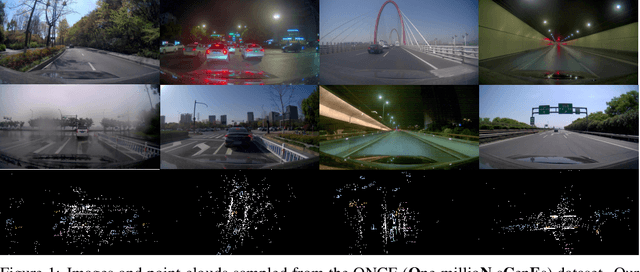
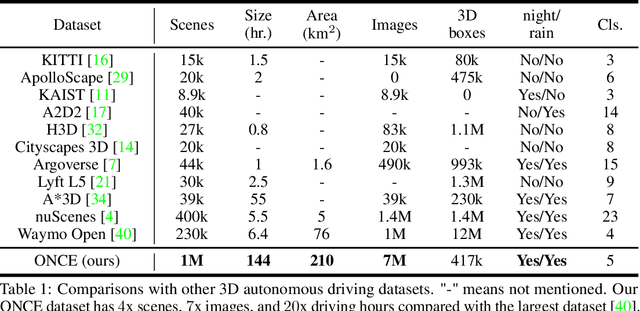
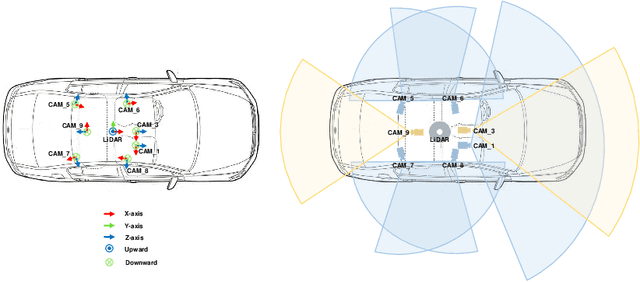

Abstract:Current perception models in autonomous driving have become notorious for greatly relying on a mass of annotated data to cover unseen cases and address the long-tail problem. On the other hand, learning from unlabeled large-scale collected data and incrementally self-training powerful recognition models have received increasing attention and may become the solutions of next-generation industry-level powerful and robust perception models in autonomous driving. However, the research community generally suffered from data inadequacy of those essential real-world scene data, which hampers the future exploration of fully/semi/self-supervised methods for 3D perception. In this paper, we introduce the ONCE (One millioN sCenEs) dataset for 3D object detection in the autonomous driving scenario. The ONCE dataset consists of 1 million LiDAR scenes and 7 million corresponding camera images. The data is selected from 144 driving hours, which is 20x longer than the largest 3D autonomous driving dataset available (e.g. nuScenes and Waymo), and it is collected across a range of different areas, periods and weather conditions. To facilitate future research on exploiting unlabeled data for 3D detection, we additionally provide a benchmark in which we reproduce and evaluate a variety of self-supervised and semi-supervised methods on the ONCE dataset. We conduct extensive analyses on those methods and provide valuable observations on their performance related to the scale of used data. Data, code, and more information are available at https://once-for-auto-driving.github.io/index.html.
 Add to Chrome
Add to Chrome Add to Firefox
Add to Firefox Add to Edge
Add to Edge